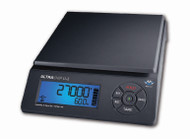15 Hacks to Lengthen the Life of Your Scale
Posted by AB on Nov 22nd 2022
15 Hacks to Lengthen the Life of Your Scale
1. A Clean Scale is a Happy Scale
Digital scales are incredibly precise instruments that must be able to detect slight changes in weight. Anything on the scale (dust, debris, dirt, etc.) can affect that weight change detection. To prevent the scale being hindered, occasionally clean your scale platform and scale body with a light disinfectant (like this Readiquat disinfectant). Always refer to your scale's user manual.
2. Fragile (Fra-gee-lay)
Banging, dropping, or throwing your scale can cause significant and most times permanent damage to the precious components of your scale. Scales, especially precision scales, are dependent on the condition of the inner sensors to produce accurate readings. To prolong the life of your scale, avoid any damage to the scale.
3. Zero is a Very Good Place to Start
It is always best to remove all items from the weighing platform before turning your scale on. During the powering up sequence, precise calibration settings are adjusted so turning on your scale with anything on the platform can cause readings that are skewed.
4. Calibration Nation
To keep your scale reading weights accurately, frequent calibrations are necessary. Even minor disturbances to the scale sensors can cause inaccurate readings. The more precise you need your readings, the more frequently you should calibrate your scale. You can get calibration weights to calibrate your scale.
5. Power Up!
Plugging your scale into a dedicated power outlet will produce more consistent readings. Sometimes when a scale shares a power outlet with another device, the electrical interference (electrical current fluctuation) can produce inconsistent results.
6. Battery Life
When you are not plugging in your scale directly into a power source and using batteries, make sure you are always using fresh batteries. Low batteries and connections that are poor lead to insufficient power to the scale which can lead to the scale not powering on or producing inconsistent results.
7. Anti-Static
Static electricity, the imbalance of electric charges within or on the surface of a material or between materials, can affect the accuracy of digital scales. Discharge all static electricity when possible (if you touch a metal object like a coin to the powered off scale) and even use an anti-static spray on both sides of the weighing platform occasionally.
8. Level It Out
Always place your digital scale on a stable and completely flat surface. Many scales will include a level bubble and feet that are adjustable so you can make 100% sure that the scale is resting evenly. Each foot has a wheel that you can turn clockwise or counterclockwise to adjust until the bubble in the level is completely centered. Changing position in between weighs can product inconsistent results. If you need to change the position or location of a scale, it is recommended that you turn off the scale before moving and power back on once it is moved.
9. No Wind Zone
Even wind speed can cause inaccurate readings on precise digital scales. Wind could interfere with the scale's sensor for pressure which would lead to inconsistent results. When at all possible, weigh your items in a wind-free environment for the most accuracy.
10. Warm It Up Before You Go Go
After you initially power on your scale, ideally give it 15-30 seconds to warm up and adjust to the environment before you being weighing items. Placing items on the scale too quickly after powering on (or having an item on the scale platform before powering on) can result in inaccurate readings.
11. Climate Culture
The optimal temperature for storage and use of digital scales is usually around 50-104° F (10-40° C). Any temperature outside of this range can cause a scale to perform inaccurately. Between being stored in warehouses, shipping, and being delivered in the extreme cold/hot months of the year, scales can go through a lot of temperature changes. It is recommended that you allow your scale to rest within the optimal temperature range for at least 24 hours before you begin using your scale.
12. Radio Waves Killed the Scale Star
Radio waves can interfere with the electrical inner parts of a digital scale which can compromise the accuracy of the scale. Choose a spot for your scale that is at least 10 feet from any item that emits radio waves (like computers, tablets, cell phones, and wi-fi routers).
13. Gentle Touch
To avoid overloading the scale, items being placed on the weighing platform should be added gently. The additional pressure to the sensors from dropping or slamming an item on the platform can cause the scale to need to be recalibrated. Also adding items to the scale with care can help avoid crushing a load cell due to overload.
14. Bullseye
The load cells of digital scales produce the most accurate readings when items are loaded onto the center of the weighing platform. The largest number of sensors that can detect pressure are located in the center of the platform. If the item you are trying to weigh is too large for your scale's platform, you can use a tray or bowl that can be placed in the center of the platform to hold the items. Don't forget to tare out the weight of that tray or bowl!
15. Save Your Energy
Whether you're using a power adapter or batteries, when not using your scale power it off for longer life. If you switch from using batteries to a power adapter, take out the batteries to avoid corrosion. Powering your scale off when not in use lets the precious inner components of the scale rest and reset.
Digital Scales are an investment and if you follow these tips you can lengthen the life of your scale! Find a wide variety of digital scales for purchase at www.level7chemical.com!

